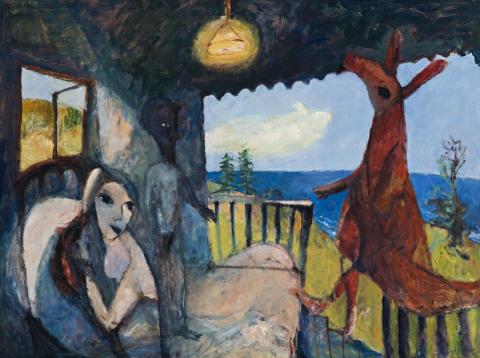ENVOY I, 1992
GARRY SHEAD
oil on composition board
91.0 x 122.0 cm
signed and dated lower right: Garry Shead / 1992
inscribed verso with title: ENVOY
Private collection, Sydney, acquired from the Wollongong City Gallery exhibition in 1992
Kangaroo: D.H. Lawrence at Thirroul, Wollongong City Gallery, New South Wales, July – September 1992
D.H. Lawrence, Art Gallery of New South Wales, Sydney, December 1993 (label attached verso)
Grishin, S., Garry Shead and the Erotic Muse, Craftsman House, Sydney, p. 101 (illus.)
Grishin, S., Garry Shead: The D.H. Lawrence Paintings, Craftsman House, Sydney, 1993, pl. 35, p. 88 (illus.)
Envoy I belongs to a group of works, exhibited initially at the Wollongong City Gallery in late 1992, which are the first manifestation of Garry Shead's exploration of the D.H. Lawrence theme. Now considered to be amongst the artist's most important works, the theme of D.H. Lawrence and his time at Thirroul would prove to be enormously inspirational for Shead.
In Lawrence, and the characters of his 1922 novel Kangaroo, we find an ambiguity of identity which Shead further explores in his paintings. The female protagonist here in Envoy I is both Harriet of the novel Kangaroo, Judith the artist's wife and a manifestation of the 'muse'. These interpretations offer the works an enduring resonance, described as 'a constantly changing fabric of ambiguity, with the blurring of identities and a complex pattern of inter-relationships is a feature of the paintings and cautions against an over-zealous literal interpretation. Not only are the central figures ambiguous in their identity, but so too is their main adversary, the Kangaroo. The Kangaroo, which appears in almost all of the paintings, is more of a presence than an identifiable character. The ubiquitous Kangaroo at times could be interpreted as Benjamin Cooley, whom Somers (of the novel) confesses to love because their souls are somewhere alike, but whom he does not want to love; at other times it seems to be the personification of the spirit of the place, a spirit which belongs to the land and which stalks these alien intruders.'1
This personification of place is a consistent thread through both Kangaroo and Shead's D.H. Lawrence paintings. Both painter and writer shared an affinity for the landscape as a mystical and alive place, the ocean a force which occurs as a theme of purification in both paintings and novel. Glimpsed from the side of the bungalow, the Pacific rises to the horizon, the burnt yellow grass of late summer covering the headland. In the final chapter of Kangaroo, the landscape eclipses the characters of Richard and Harriet as the subject of the novel, and so too in the D.H. Lawrence paintings. Beyond the scenes of human endeavour played out in the half-dark of the bungalow rooms, the coastal landscape floods in through the windows and balconies.
1. Grishin, S., Garry Shead: The D.H. Lawrence Paintings, Craftsman House, Sydney, 1993, p. 14
MERRYN SCHRIEVER
